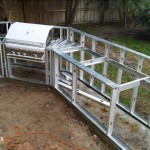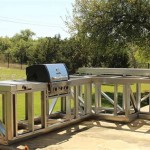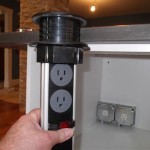Undermount Kitchen Sink: Everything You Need to Know About It
The undermount kitchen sink has become a popular choice for homeowners seeking a clean, modern aesthetic in their kitchens. Unlike top-mount (or drop-in) sinks, undermount sinks are installed beneath the countertop, creating a seamless transition between the sink and the surrounding surface. This installation method offers several advantages in terms of aesthetics, functionality, and hygiene. This article will delve into the specifics of undermount kitchen sinks, covering their benefits, drawbacks, different types, installation considerations, and maintenance tips, providing a comprehensive understanding of these stylish and practical fixtures.
What are the benefits of Undermount Kitchen Sinks?
Undermount kitchen sinks provide a number of advantages compared to their top-mount counterparts. These advantages contribute to both the form and function of the kitchen space.
One of the primary benefits is the sleek, minimalist appearance. The absence of a visible lip or rim on the countertop allows for a smooth, uninterrupted surface. This not only enhances the visual appeal of the kitchen but also makes cleaning significantly easier. Crumbs and spills can be directly wiped from the countertop into the sink without encountering any obstructions.
Furthermore, undermount sinks often offer more usable countertop space. The absence of a self-rimming edge provides a slightly larger working area around the sink, which can be particularly beneficial in smaller kitchens. This additional space can be used for food preparation, utensil placement, or other tasks.
The design of undermount sinks can also contribute to better hygiene. The smooth transition between the countertop and the sink basin eliminates crevices where dirt and bacteria can accumulate. Regular cleaning is more effective, promoting a healthier kitchen environment.
Another advantage is the potential for improved resale value. A modern, well-maintained kitchen is a significant selling point for any home. Undermount sinks are often perceived as a high-end feature, which can contribute to a more favorable impression among potential buyers.
In addition to the aesthetic and functional benefits, undermount sinks can also be more durable. Because they are supported by the countertop from underneath, they are less likely to warp or become dislodged over time compared to some top-mount models.
Potential Drawbacks to Consider
While undermount sinks offer numerous advantages, there are also potential drawbacks that homeowners should consider before making a purchase. Understanding these disadvantages can help in making an informed decision about whether an undermount sink is the right choice for a particular kitchen.
One of the main concerns is the installation complexity and cost. Undermount sinks require professional installation to ensure proper sealing and support. This can add to the overall cost of the project, especially if modifications to the countertop are necessary. The countertop material must be strong enough to support the weight of the sink and the water it contains; therefore, laminate countertops are generally not recommended for undermount sink installation.
The need for a solid surface countertop, such as granite, quartz, or solid acrylic, can also be a significant factor. These materials are more expensive than laminate, which is a common choice for budget-conscious homeowners. The cost of the countertop material, combined with the installation fees, can make undermount sinks a more expensive option overall.
Repairs and replacements can also be more challenging and costly. If the sink needs to be replaced, it often requires removing and replacing the countertop, which can be a significant undertaking. This is in contrast to top-mount sinks, which can usually be replaced without disturbing the countertop.
Another potential drawback is the limited range of materials suitable for undermount sink installation. While stainless steel, cast iron, and composite materials are common choices, lighter-weight materials may not be as durable or structurally sound for this type of installation. This can limit the design options available.
Finally, some homeowners may find the deeper basin of undermount sinks uncomfortable. The lack of a rim or lip can sometimes lead to water splashing onto the countertop and floor. The depth of the basin can also require more reaching, which may be a concern for individuals with mobility issues.
Types of Undermount Kitchen Sinks
Undermount kitchen sinks are available in a variety of materials, shapes, and configurations to suit different kitchen styles and functional needs. Understanding the different types can help homeowners choose the best option for their specific requirements.
Material Types:
Stainless Steel: This is one of the most popular choices for undermount sinks due to its durability, resistance to staining and corrosion, and ease of cleaning. Stainless steel sinks are available in various gauges (thicknesses), with lower gauge numbers indicating thicker and more durable steel. However, stainless steel can be prone to scratching and water spots.
Cast Iron: Cast iron sinks are known for their durability and heat resistance. They are typically coated with enamel, which provides a smooth, non-porous surface that is resistant to staining and scratching. However, cast iron sinks are very heavy, requiring strong countertop support, and the enamel coating can chip over time.
Quartz Composite: These sinks are made from a blend of quartz and acrylic resins, offering a durable and stain-resistant surface. Quartz composite sinks are available in a variety of colors and textures, making them a versatile choice for different kitchen designs. They are also relatively resistant to scratches and heat.
Granite Composite: Similar to quartz composite, granite composite sinks are made from a blend of granite particles and acrylic resins. They offer similar benefits in terms of durability, stain resistance, and heat resistance. Granite composite sinks typically have a more natural appearance than quartz composite sinks.
Fireclay: Fireclay sinks are made from a type of ceramic clay that is fired at high temperatures, resulting in a dense and durable material. Fireclay sinks are known for their smooth, glossy finish and resistance to staining and scratching. However, they can be more expensive than other types of sinks.
Shape and Configuration:
Single Bowl: Single bowl sinks consist of one large basin, providing ample space for washing large pots and pans. They are a good choice for smaller kitchens where space is limited.
Double Bowl: Double bowl sinks consist of two separate basins, allowing for simultaneous washing and rinsing. They are a popular choice for larger kitchens and households with multiple cooks.
Equal Bowls: Double bowl sinks with equal-sized basins are useful for separating clean and dirty dishes or for performing different tasks at the same time.
Unequal Bowls: Double bowl sinks with different-sized basins provide flexibility for various kitchen tasks. The larger bowl can be used for washing larger items, while the smaller bowl can be used for rinsing or food preparation.
Corner Sinks: Corner sinks are designed to fit into the corner of a kitchen countertop, maximizing space utilization. They are often used in smaller kitchens or kitchens with unconventional layouts.
Farmhouse Sinks: While traditionally top-mount, farmhouse sinks are now also available in undermount versions. These sinks feature an exposed front apron, adding a rustic or traditional touch to the kitchen design.
Choosing the right type of undermount sink depends on individual preferences, kitchen size, and functional needs. Considering the material, shape, and configuration will ensure that the selected sink meets the specific requirements of the kitchen space.
The installation of an undermount sink is a critical step that can significantly impact its performance and longevity. Proper installation ensures that the sink is securely mounted to the countertop, prevents leaks, and provides a seamless transition between the sink and the surrounding surface. It is generally recommended that this task be done by a professional.
Installation Considerations
Prior to installation, the countertop must be properly prepared. The countertop material should be strong enough to support the weight of the sink when it is full of water. Materials like granite, quartz, or solid acrylic are generally recommended. Laminate countertops are typically not suitable for undermount sinks due to their lack of structural integrity and susceptibility to water damage.
The cut-out in the countertop must be precise to ensure a snug fit for the sink. A template is typically provided with the sink, which should be used to accurately mark the cut-out area. The cut-out should be slightly smaller than the sink to allow for a small overhang of the countertop, which helps to conceal any minor imperfections in the cut.
The sink is typically attached to the countertop using epoxy, silicone sealant, or specialized mounting clips. Epoxy provides a strong and durable bond, while silicone sealant offers flexibility and water resistance. Mounting clips are used to provide additional support and stability, particularly for heavier sinks. The choice of adhesive and mounting method depends on the type of sink, countertop material, and personal preference.
Once the sink is attached to the countertop, it is important to ensure that it is level and properly aligned. A level can be used to check the sink's horizontal and vertical alignment. Any necessary adjustments should be made before the adhesive fully cures. A bead of silicone sealant should be applied around the perimeter of the sink to create a watertight seal and prevent water from seeping between the sink and the countertop.
Plumbing connections, including the drain and water supply lines, should be securely connected to the sink. Check for leaks and tighten connections as needed. A professional plumber is usually recommended for this portion to ensure that all connections are secure and compliant with local plumbing codes.
After the installation is complete, allow the adhesive to fully cure before using the sink. Follow the manufacturer's instructions for curing time and any specific care instructions. Inspect the installation for any signs of leaks or misalignment. If any problems are detected, address them promptly to prevent further damage.
In addition to these considerations, it is important to follow all safety precautions during the installation process. Wear appropriate safety gear, such as eye protection and gloves, and use caution when handling sharp tools and heavy objects. If you are not comfortable performing the installation yourself, it is best to hire a professional installer to ensure that the job is done correctly and safely.
Proper maintenance of an undermount kitchen sink is essential for preserving its appearance and extending its lifespan. Regular cleaning and care can prevent staining, scratching, and other forms of damage. Different materials require different cleaning methods and products, so it's essential to use the appropriate cleaning agents.
Maintenance and Care Tips
Stainless Steel Sinks:
Clean stainless steel sinks regularly with a mild dish soap and warm water. Use a soft sponge or cloth to avoid scratching the surface. Rinse thoroughly and dry with a clean towel to prevent water spots.
For stubborn stains or water spots, use a stainless steel cleaner or polish. Follow the manufacturer's instructions and test the cleaner in an inconspicuous area first to ensure it does not damage the surface.
Avoid using abrasive cleaners, steel wool, or scouring pads, as they can scratch the stainless steel surface. Also, avoid leaving acidic foods or liquids on the surface for extended periods, as they can cause staining or corrosion.
Cast Iron Sinks:
Clean cast iron sinks with enamel coating regularly with a mild dish soap and warm water. Use a soft sponge or cloth to avoid scratching the enamel surface. Rinse thoroughly and dry with a clean towel.
For stubborn stains, use a non-abrasive cleaner specifically designed for enamel surfaces. Follow the manufacturer's instructions and test the cleaner in an inconspicuous area first.
Avoid using abrasive cleaners, steel wool, or scouring pads, as they can scratch the enamel coating. Also, avoid dropping heavy objects into the sink, as this can cause the enamel to chip or crack.
Quartz and Granite Composite Sinks:
Clean quartz and granite composite sinks regularly with a mild dish soap and warm water. Use a soft sponge or cloth to avoid scratching the surface. Rinse thoroughly and dry with a clean towel.
For stubborn stains, use a cleaner specifically designed for quartz or granite composite surfaces. Follow the manufacturer's instructions and test the cleaner in an inconspicuous area first.
Avoid using abrasive cleaners, steel wool, or scouring pads, as they can scratch the surface. Also, avoid exposing the sink to extreme heat or sharp objects, as this can cause damage.
General Tips:
Always rinse the sink thoroughly after each use to remove food particles and other debris.
Use a sink grid or mat to protect the bottom of the sink from scratches and dents.
Avoid pouring grease or oil down the drain, as this can clog the drain pipes. Instead, dispose of grease in a separate container.
Periodically clean the drain with a drain cleaner or a mixture of baking soda and vinegar to prevent clogs.
By following these maintenance and care tips, homeowners can keep their undermount kitchen sinks looking their best for years to come. Regular cleaning and care can prevent damage, prolong the life of the sink, and maintain a hygienic kitchen environment.

Everything You Need To Know About Kitchen Sink Styles

Aura Sink Everything You Need To Know House Of Countertops
Kitchen Sink Guide Signature Hardware

Everything You Ever Wanted To Know About Undermount Kitchen Sinks Mensarjor Com

How To Choose A Kitchen Sink Capitol Kitchens And Baths

Everything You Need To Know About Kitchen Sinks World Coppersmith

Undermount Kitchen Sinks By Blanco

An Undermount Sink In Laminate Countertops

Choosing A Kitchen Sink Top Mount Or Undermount

Dual Mount Kitchen Sinks What You Need To Know Trubuild Construction
Related Posts








